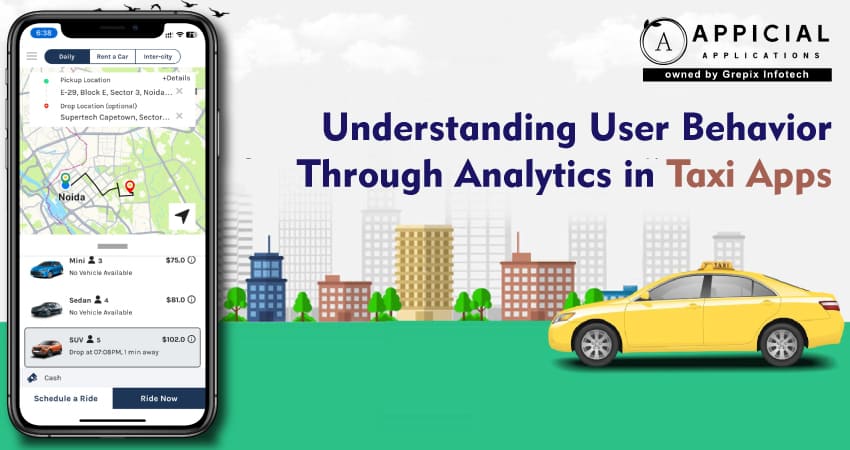
Understanding User Behavior Through Analytics in Taxi Apps
The advent of taxi apps has transformed the transportation landscape, offering unprecedented convenience and efficiency. Platforms like Uber, Lyft, and Grab have redefined how people commute, making ride-hailing as simple as tapping a smartphone screen. Behind this seamless user experience lies a robust framework of data analytics that deciphers user behavior. By leveraging analytics, taxi apps not only enhance user satisfaction but also optimize operations and maintain a competitive edge in a saturated market. This blog explores how analytics in taxi apps contribute to understanding user behavior and the multifaceted benefits that ensue.
The advent of taxi apps has revolutionized urban mobility, seamlessly integrating convenience and efficiency into daily commutes. Companies like Uber, Lyft, and Grab have utilized data analytics to enhance user experiences and streamline operations. This process involves collecting extensive data from user profiles, location tracking, and interaction analytics to understand and predict user behavior. By applying descriptive, predictive, and prescriptive analytics, these platforms can offer personalized services, optimize routing, adjust pricing dynamically, and improve service reliability. Such strategic use of analytics not only boosts customer satisfaction but also gives these companies a competitive advantage in the fast-paced, tech-driven marketplace. This comprehensive examination reveals how deeply data analytics is embedded in the operational frameworks of modern taxi applications, underscoring its critical role in shaping the future of transportation.
The Importance of Understanding User Behavior
In today's data-driven world, understanding user behavior is pivotal for several reasons:
- Personalization: Tailoring services to individual preferences increases user engagement and loyalty.
- Operational Efficiency: Insights into user patterns enable better resource allocation, reducing wait times and improving route planning.
- Strategic Marketing: Knowledge of user preferences facilitates targeted marketing campaigns that resonate with specific audiences.
- Competitive Advantage: Deep user insights allow companies to differentiate their services, attracting and retaining more users.
Data Collection in Taxi Apps
Before analyzing user behavior, taxi apps must collect relevant data. The primary sources include:
- User Profiles: Information such as age, gender, and payment preferences helps in segmenting the user base.
- Location Data: GPS tracking of pick-up and drop-off points provides insights into popular routes and areas of high demand.
- Ride History: Past trips, including destinations and frequency, reveal travel patterns.
- App Interaction: Data on how users navigate the app, features utilized, and time spent indicate engagement levels.
- Feedback and Ratings: User reviews and ratings for drivers and the service highlight areas for improvement.
Analytics Techniques Employed
To make sense of the collected data, taxi apps employ various analytics techniques:
1 Descriptive Analytics
Descriptive analytics summarizes historical data to understand what has happened. Examples include:
- Identifying Peak Usage Times: Determining hours when demand is highest helps in resource planning.
- Mapping Popular Routes: Recognizing frequently traveled routes aids in optimizing service coverage.
- User Segmentation: Categorizing users based on behavior patterns allows for tailored services.
2 Predictive Analytics
Predictive models forecast future trends based on historical data:
- Demand Forecasting: Anticipating areas and times with high demand ensures adequate driver availability.
- Churn Prediction: Identifying users likely to discontinue the service enables proactive retention strategies.
- Dynamic Pricing: Adjusting prices based on predicted demand and supply balances the market effectively.
Ideal for: Large ride-hailing companies looking to expand globally while offering a variety of payment options.
3 Prescriptive Analytics
Prescriptive analytics suggests actions to achieve desired outcomes:
- Route Optimization: Recommending the most efficient routes reduces travel time and fuel consumption.
- Resource Allocation: Advising on driver positioning during peak times enhances service efficiency.
- Marketing Recommendations: Providing insights for personalized promotions increases campaign effectiveness.
Understanding Specific User Behaviors
Analytics aid in identifying particular user behaviors, which is essential for improving services.
1 Ride Patterns
By analyzing ride histories, apps can identify:
- Frequent Destinations: Recognizing common endpoints like workplaces or airports allows for targeted services.
- Time Preferences: Understanding when users typically request rides helps in demand forecasting.
- Mode Preferences: Knowing whether users prefer shared rides, luxury options, or standard services informs service offerings.
2 Payment Preferences
Data on payment methods reveals:
- Preferred Payment Types: Catering to popular payment options enhances user convenience.
- Spending Habits: Insights into average spend per ride and price sensitivity guide pricing strategies.
3 App Engagement
Monitoring app interaction indicates:
- Feature Utilization: Understanding which features are most used helps in prioritizing app development efforts.
- User Experience Issues: Identifying frequent app crashes or booking abandonment highlights areas needing improvement.
Enhancing User Experience Through Analytics
Understanding user behavior enables taxi apps to refine the user experience significantly.
1 Personalization
- Customized Offers: Providing discounts on frequently used routes increases user satisfaction.
- Preferred Drivers: Matching users with drivers they have rated highly enhances comfort and trust.
- Language Preferences: Adapting app language based on user settings or location improves accessibility.
2 Reducing Wait Times
- Predictive analytics allows for efficient driver allocation, reducing wait times and improving service reliability.
3 Improving Safety and Trust
- Driver Verification: Unusual driving behavior can be identified by analytics, which can lead to reviews and uphold safety regulations.
- Emergency Features: Highlighting safety features during late hours or in certain areas increases user confidence.
4 Feedback Utilization
Analyzing feedback helps in:
- Service Improvements: Addressing common complaints leads to enhanced user satisfaction.
- Driver Training: Providing targeted training based on user ratings improves overall service quality.
Operational Benefits
Beyond enhancing user experience, analytics contribute to operational efficiency.
1 Dynamic Pricing Models
Implementing surge pricing during high-demand periods balances supply and demand, optimizing earnings for drivers and service availability for users.
2 Fleet Management
- Driver Allocation: Ensuring driver availability aligns with demand patterns.
- Maintenance Scheduling: Predictive maintenance based on usage data reduces downtime.
3 Fraud Detection
Analytics can detect anomalies indicating fraudulent activities, safeguarding the company and users.
Marketing and Retention Strategies
User behavior insights are invaluable for crafting effective marketing and retention strategies.
1 Targeted Promotions
- Personalized Discounts: Offering deals that align with user preferences increases conversion rates.
- Loyalty Programs: Rewarding frequent users fosters loyalty and repeat business.
2 Re-engagement Campaigns
- Win-back Strategies: Incentivizing inactive users to return enhances user retention.
- Churn Reduction: Addressing the factors leading to user drop-off maintains a stable user base.
Ethical Considerations
While analytics offer numerous benefits, ethical considerations must not be overlooked.
1 Data Privacy
- Consent: Users should be informed about data collection and its purposes.
- Anonymization: Personal data should be anonymized to protect user identities.
2 Bias and Fairness
- Algorithmic Bias: Ensuring predictive models do not discriminate against any user group is essential.
- Transparency: Being open about how data influences service delivery builds trust.
Challenges in Implementing Analytics
Implementing analytics comes with its set of challenges:
1 Data Quality
- Incomplete Data: Missing or inaccurate data can lead to flawed insights.
- Data Integration: Combining data from various sources requires robust systems.
2 Technical Infrastructure
- Scalability: Systems must handle large data volumes efficiently.
- Security: Protecting data from breaches is crucial.
3 Regulatory Compliance
- GDPR and Other Laws: Complying with data protection regulations is mandatory to avoid legal repercussions.
Future Trends
The role of analytics in taxi apps continues to evolve with emerging technologies.
1 Artificial Intelligence and Machine Learning
- Advanced Predictive Models: AI enhances the accuracy of demand forecasting and personalization.
- Chatbots and Virtual Assistants: AI-powered interfaces improve user interaction and support.
2 Internet of Things (IoT)
- Connected Vehicles: Real-time vehicle data enhances route optimization and safety measures.
3 Integration with Other Services
- Multimodal Transportation: Combining data with public transit systems offers comprehensive transportation solutions.
Conclusion
Understanding user behavior through analytics is imperative for taxi apps aiming to excel in a competitive and ever-evolving transportation landscape. By harnessing data from user profiles, location tracking, ride history, app interactions, and feedback, companies can personalize services, enhance operational efficiency, and implement strategic marketing initiatives that resonate with their user base. Employing descriptive, predictive, and prescriptive analytics allows for informed decision-making that not only improves user satisfaction but also optimizes resource allocation and boosts overall performance.
However, it's essential to navigate the ethical considerations surrounding data privacy, algorithmic bias, and regulatory compliance. Ensuring transparency, obtaining user consent, and protecting personal data are critical steps in building and maintaining user trust.
Appicial Applications is a leading taxi app development company, we recognize the transformative power of analytics in redefining user experiences and operational excellence within taxi apps. Our solutions help you effectively collect and analyze data, implement advanced analytics techniques, and stay ahead of future trends like AI, machine learning, and IoT integration. By partnering with us, you can leverage these insights to create personalized, efficient, and trustworthy services that meet the evolving needs of your users while securing a competitive edge in the market.
Looking out to start your own venture like Uber? Try out our HireMe Uber Clone, the easiest way to kick-start your taxi business.






